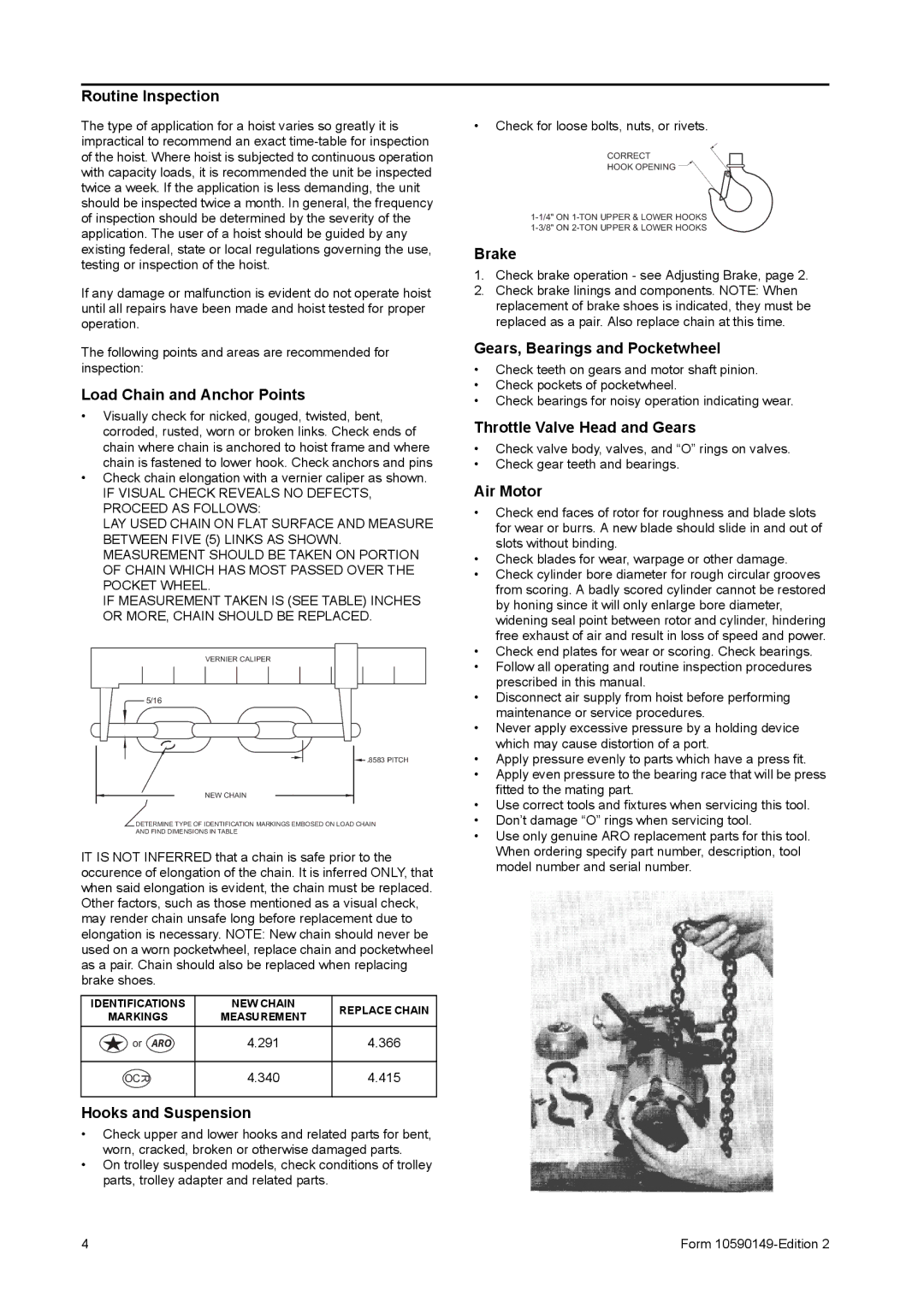
Routine Inspection
The type of application for a hoist varies so greatly it is impractical to recommend an exact
If any damage or malfunction is evident do not operate hoist until all repairs have been made and hoist tested for proper operation.
The following points and areas are recommended for inspection:
Load Chain and Anchor Points
•Visually check for nicked, gouged, twisted, bent, corroded, rusted, worn or broken links. Check ends of chain where chain is anchored to hoist frame and where chain is fastened to lower hook. Check anchors and pins
•Check chain elongation with a vernier caliper as shown.
IF VISUAL CHECK REVEALS NO DEFECTS, PROCEED AS FOLLOWS:
LAY USED CHAIN ON FLAT SURFACE AND MEASURE BETWEEN FIVE (5) LINKS AS SHOWN. MEASUREMENT SHOULD BE TAKEN ON PORTION OF CHAIN WHICH HAS MOST PASSED OVER THE POCKET WHEEL.
IF MEASUREMENT TAKEN IS (SEE TABLE) INCHES OR MORE, CHAIN SHOULD BE REPLACED.
VERNIER CALIPER
![]() 5/16
5/16
![]() .8583 PITCH
.8583 PITCH
NEW CHAIN
DETERMINE TYPE OF IDENTIFICATION MARKINGS EMBOSED ON LOAD CHAIN
AND FIND DIMENSIONS IN TABLE
IT IS NOT INFERRED that a chain is safe prior to the occurence of elongation of the chain. It is inferred ONLY, that when said elongation is evident, the chain must be replaced. Other factors, such as those mentioned as a visual check, may render chain unsafe long before replacement due to elongation is necessary. NOTE: New chain should never be used on a worn pocketwheel, replace chain and pocketwheel as a pair. Chain should also be replaced when replacing brake shoes.
IDENTIFICATIONS | NEW CHAIN | REPLACE CHAIN | |
MARKINGS | MEASUREMENT | ||
| |||
or ARO | 4.291 | 4.366 | |
OCR | 4.340 | 4.415 |
Hooks and Suspension
•Check upper and lower hooks and related parts for bent, worn, cracked, broken or otherwise damaged parts.
•On trolley suspended models, check conditions of trolley
parts, trolley adapter and related parts.
•Check for loose bolts, nuts, or rivets.
CORRECT
HOOK OPENING
Brake
1.Check brake operation - see Adjusting Brake, page 2.
2.Check brake linings and components. NOTE: When replacement of brake shoes is indicated, they must be replaced as a pair. Also replace chain at this time.
Gears, Bearings and Pocketwheel
•Check teeth on gears and motor shaft pinion.
•Check pockets of pocketwheel.
•Check bearings for noisy operation indicating wear.
Throttle Valve Head and Gears
•Check valve body, valves, and “O” rings on valves.
•Check gear teeth and bearings.
Air Motor
•Check end faces of rotor for roughness and blade slots for wear or burrs. A new blade should slide in and out of slots without binding.
•Check blades for wear, warpage or other damage.
•Check cylinder bore diameter for rough circular grooves from scoring. A badly scored cylinder cannot be restored by honing since it will only enlarge bore diameter, widening seal point between rotor and cylinder, hindering free exhaust of air and result in loss of speed and power.
•Check end plates for wear or scoring. Check bearings.
•Follow all operating and routine inspection procedures prescribed in this manual.
•Disconnect air supply from hoist before performing maintenance or service procedures.
•Never apply excessive pressure by a holding device which may cause distortion of a port.
•Apply pressure evenly to parts which have a press fit.
•Apply even pressure to the bearing race that will be press fitted to the mating part.
•Use correct tools and fixtures when servicing this tool.
•Don’t damage “O” rings when servicing tool.
•Use only genuine ARO replacement parts for this tool. When ordering specify part number, description, tool model number and serial number.
4 | Form |
